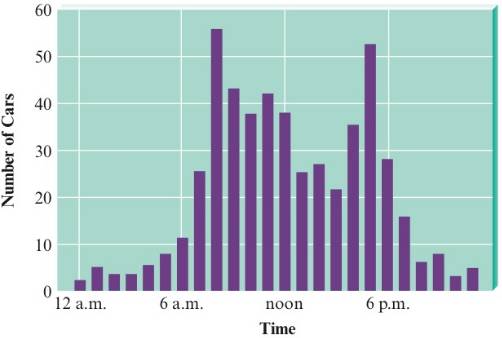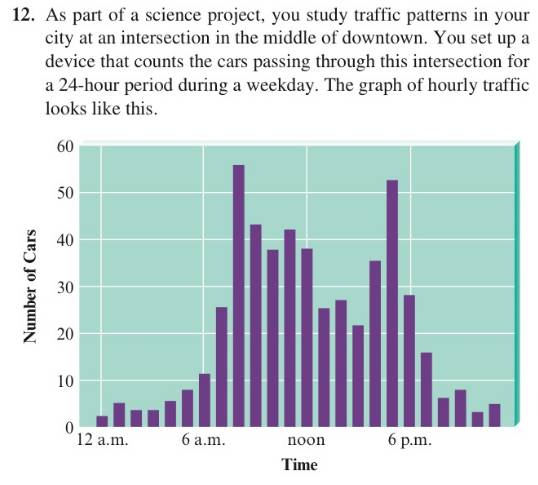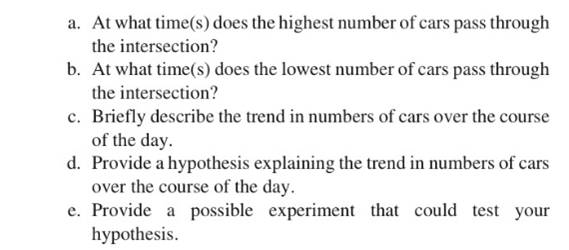
Introductory Chemistry >IC<
8th Edition
ISBN: 9781305014534
Author: ZUMDAHL
Publisher: CENGAGE C
expand_more
expand_more
format_list_bulleted
Concept explainers
Textbook Question
Chapter 1, Problem 12ALQ
As part of a science project, you study traffic patterns in your city at an intersection in the middle of downtown. You set up a device that counts the cars passing through this intersection for a 24-hour period during a weekday. The graph of hourly traffic looks like this.

- At what lime(s) does the highest number of cars pass through the intersection?
- At what time(s) does the lowest number of cars pass through the intersection?
- Briefly describe the trend in numbers of cars over the course of the day.


Expert Solution & Answer
Trending nowThis is a popular solution!

Students have asked these similar questions
Which of the following are TRUE about linear syntheses?
Question 7Select one:
A.
They are easier to execute
B.
They are the most efficient strategy for all syntheses
C.
They are generally shorter than convergent syntheses
D.
They are less versatile compared to convergent syntheses
Which of the following characteristics is common among chiral pool substrates?
Question 4Select one:
A.
They have good leaving groups
B.
They are all achiral
C.
All have a multiplicity of chiral centres
D.
They have poor leaving groups
Determine whether the following reaction is an example of a nucleophilic substitution reaction:
H
NO2
H+
NO 2
+
Molecule A
Molecule B
Is this a nucleophilic substitution reaction?
If this is a nucleophilic substitution reaction, answer the remaining questions in this table.
What word or two-word phrase is used to describe the role Molecule A plays in this reaction?
What word or two-word phrase is used to describe the role Molecule B plays in this reaction?
Use a 6 + symbol to label the electrophilic carbon that is attacked during the substitution.
Highlight the leaving group on the appropriate reactant.
O Yes
○ No
☐
0
dx
000
HE
?
Chapter 1 Solutions
Introductory Chemistry >IC<
Ch. 1.4 - What if everyone in the government used the...Ch. 1 - Discuss how a hypothesis can become a theory. Can...Ch. 1 - Make five qualitative and five quantitative...Ch. 1 - Prob. 3ALQCh. 1 - Differentiate between a “theory” and a “scientific...Ch. 1 - Describe three situations when you used the...Ch. 1 - Scientific models do not describe reality. They...Ch. 1 - Theories should inspire questions. Discuss a...Ch. 1 - Describe how you would set up an experiment to...Ch. 1 - Prob. 9ALQ
Ch. 1 - As stated in the text, there is no one scientific...Ch. 1 - Prob. 11ALQCh. 1 - As part of a science project, you study traffic...Ch. 1 - Prob. 13ALQCh. 1 - Chemistry is an intimidating academic subject for...Ch. 1 - The first paragraphs in this chapter ask you if...Ch. 1 - This section presents several ways our day-to-day...Ch. 1 - The Chemistry in Focus segment titled Dr....Ch. 1 - This textbook provides a specific definition of...Ch. 1 - We use chemical reactions in our everyday lives,...Ch. 1 - Prob. 7QAPCh. 1 - Being a scientist is very much like being a...Ch. 1 - In science, what is the difference between a law...Ch. 1 - Observations may be either qualitative or...Ch. 1 - Prob. 11QAPCh. 1 - True or false? If a theory is disproven, then all...Ch. 1 - Although, in general, science has advanced our...Ch. 1 - Discuss several political, social, or personal...Ch. 1 - Although reviewing your lecture notes and reading...Ch. 1 - Why is the ability to solve problems important in...Ch. 1 - Students approaching the study of chemistry must...Ch. 1 - The ‘Chemistry in Focus” segmentChemistry: An...
Knowledge Booster
Learn more about
Need a deep-dive on the concept behind this application? Look no further. Learn more about this topic, chemistry and related others by exploring similar questions and additional content below.Similar questions
- Draw the major organic product of the Bronsted acid-base reaction. Include all lone pairs and charges as appropriate. Ignore any counterions. :0: NaOH Harrow_forward5. Calculate the total amount of heat transferred as 50 g of wat Specific heat H₂O (g) 2.00 J/g°C -10 °C. Specific heat H₂O (1) Specific heat H₂O (s) 4.18 J/g°C 2.11 J/g°C Heat of vaporization 2260 J/g Heat of fusion 334 J/g Melting point 0°C 6. Calculate the total amount of heat transferred as 25 g of water is heated from 50 °C to 100 °C as a gas. Boiling point 100 °Carrow_forwardCalculate the total amount of heat transferred as 50 g of Water -10°C. Calculate the total amount of heat transferred as 25 g of water is heated from 50°C to 100°C as a gas. \table[[Specific heat H₂O(g), 2.00°C Η 2 g 5. Calculate the total amount of heat transferred as 50 g of wat Specific heat H₂O (g) 2.00 J/g°C -10 °C. 4.18 J/g°C 2.11 J/g°C 2260 J/g 334 J/g Specific heat H₂O (1) Specific heat H₂O (s) Heat of vaporization Heat of fusion Melting point 6. Calculate the total amount of heat transferred as 25 g of water is heated from 50 °C to 100 °C as a gas. Boiling point 100 °C 0°Carrow_forward
- Write formulas for ionic compounds composed of the following ions. Use units as a guide to your solutions. 24. sodium and nitrate 25. calcium and chlorate 26. aluminum and carbonate 27. CHALLENGE Write the formula for an ionic compound formed by ions from a group 2 element and polyatomic ions composed of only carbon and oxygen.show work step by steparrow_forwardADDITIONAL PRACTICE PRACTICE Problems Write formulas for ionic compounds composed of the following ions. Use units as a guide to your solutions. 24. sodium and nitrate 25. calcium and chlorate 26. aluminum and carbonate 27. CHALLENGE Write the formula for an ionic compound formed by ions from a group 2 element and polyatomic ions composed of only carbon and oxygen. ounds 1998arrow_forward7:35 < Dji Question 19 of 22 5G 50% Submit What is the pH of a buffer made from 0.350 mol of HBrO (Ka = 2.5 × 10-9) and 0.120 mol of KBRO in 2.0 L of solution? | 1 2 3 ☑ 4 5 6 C 7 8 ☐ 9 +/- Tap here for additional resources ||| 0 ×10 Гarrow_forward
- aw the major substitution products you would expect for the reaction shown below. If substitution would not occur at a significant rate under these conditions, check the box underneath the drawing area instead. Be sure you use wedge and dash bonds where necessary, for example to distinguish between major products. Note for advanced students: you can assume that the reaction mixture is heated mildly, somewhat above room temperature, but strong heat or reflux is not used. B C Br HO O Substitution will not occur at a significant rate. Explanation Check + Х Click and drag to start drawing a structure. © 2025 McGraw Hill LLC. All Rights Reserved. Terms of Use | Privacy Center | Accessibarrow_forwardComplete the following reactions with the necessary reagents to complete the shown transformation. Example: 1. 2. ? 3. 018 Br OH Answer: H₂O, H2SO4, HgSO4arrow_forward7:34 • < Question 18 of 22 5G 50% Submit What is the pH of a buffer made from 0.220 mol of HCNO (Ka = 3.5 × 10-4) and 0.410 mol of NaCNO in 2.0 L of solution? 1 2 3 ☑ 4 5 6 C 7 8 | 9 +/- 0 ×10 Tap here for additional resources ||| Гarrow_forward
- 6:46 ✔ 5G 58% < Question 7 of 22 Submit What is the primary species in solution at the halfway point in a titration of NH3 with HBr? A NH3 and H+ B NH₁+ and H+ C NH4+ D NH3 and NH4+ Tap here for additional resources |||arrow_forward6:49 Dji < Question 15 of 22 4G 57% Submit The pOH of a solution is 10.50. What is the OH- concentration in the solution? A 3.2 × 10-4 M B C 3.2 x 10-11 M 10.50 M D 4.2 M E 3.50 M Tap here for additional resources |||arrow_forwardヨ 6:49 Dji < Question 13 of 22 5G 57% Submit The pH of a solution is 2.40. What is the H+ concentration in the solution? A B 2.5 x 10-12 M 4.0 × 10-3 M C 2.40 M D 4.76 M 11.60 M Tap here for additional resources |||arrow_forward
arrow_back_ios
SEE MORE QUESTIONS
arrow_forward_ios
Recommended textbooks for you
 ChemistryChemistryISBN:9781305957404Author:Steven S. Zumdahl, Susan A. Zumdahl, Donald J. DeCostePublisher:Cengage Learning
ChemistryChemistryISBN:9781305957404Author:Steven S. Zumdahl, Susan A. Zumdahl, Donald J. DeCostePublisher:Cengage Learning
 Chemistry: The Molecular ScienceChemistryISBN:9781285199047Author:John W. Moore, Conrad L. StanitskiPublisher:Cengage Learning
Chemistry: The Molecular ScienceChemistryISBN:9781285199047Author:John W. Moore, Conrad L. StanitskiPublisher:Cengage Learning Introductory Chemistry: A FoundationChemistryISBN:9781337399425Author:Steven S. Zumdahl, Donald J. DeCostePublisher:Cengage Learning
Introductory Chemistry: A FoundationChemistryISBN:9781337399425Author:Steven S. Zumdahl, Donald J. DeCostePublisher:Cengage Learning

Chemistry
Chemistry
ISBN:9781305957404
Author:Steven S. Zumdahl, Susan A. Zumdahl, Donald J. DeCoste
Publisher:Cengage Learning


Chemistry: The Molecular Science
Chemistry
ISBN:9781285199047
Author:John W. Moore, Conrad L. Stanitski
Publisher:Cengage Learning

Introductory Chemistry: A Foundation
Chemistry
ISBN:9781337399425
Author:Steven S. Zumdahl, Donald J. DeCoste
Publisher:Cengage Learning
Types of Matter: Elements, Compounds and Mixtures; Author: Professor Dave Explains;https://www.youtube.com/watch?v=dggHWvFJ8Xs;License: Standard YouTube License, CC-BY